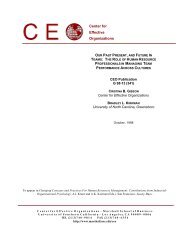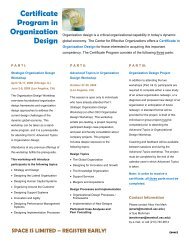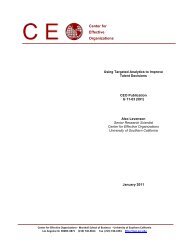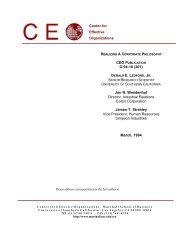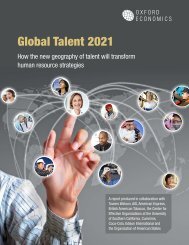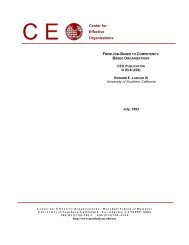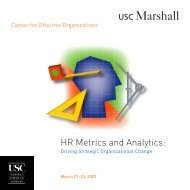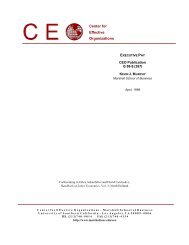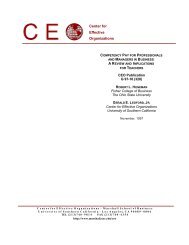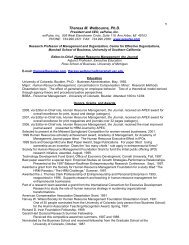Center for Effective Organizations - University of Southern California
Center for Effective Organizations - University of Southern California
Center for Effective Organizations - University of Southern California
Create successful ePaper yourself
Turn your PDF publications into a flip-book with our unique Google optimized e-Paper software.
Greiner: Well, what about organization or leadership? Your old domains?Kerr: Some leadership models, like the Fiedler model, I don’t think any practitioner would use,it’s too much <strong>of</strong> a black box. But I still find very useful the Vroom model…it’s a thoughtful wayto decide when you consult, when do you delegate, when do you make a unilateral decision.There are also elements <strong>of</strong> the path-goal stuff; again, I love the “ability x motivation =per<strong>for</strong>mance” You have to understand peoples capacity to do things. And you also have toincrease their desire to go do them.Greiner: What about your old classic,” The Folly <strong>of</strong> Rewarding A While Hoping <strong>for</strong> B?”Kerr: It’s funny, only two weeks ago, a colleague sent me an e-mail, “By the way, you shouldknow, I just used your article in one <strong>of</strong> my staff meetings.” It’s ironic, because it was builtaround a false assumption, which is that these things happen through ignorance, and here’s thearticle and people read it, and read it, and read it, and yet these things continue to happen. So,my guess about causation must be wrong, because if I was right we should have had the capacityto fix it. There’s something odd about how people build reward systems that are divergent withthe goals they hope to attain. There’s got to be something quirkier, or more deep-rooted in thehuman psyche, because we just keep doing it. We still don’t incentivize people enough. If <strong>for</strong>example, at GE, if you want to cross-market, and you say the commission is going to be$110,000, who gets it? Well, is it 80/ 20% or 70/30%? Or 50/50%? The result is fighting, andthe bickering. I remember Welch saying, “Here’s what we’re going to do. If the commission is$110,000, if two departments or two people share it, they each get 100%.” In one swoop, younow have a tremendous incentive to cross-market.When I was Program Chair at the Academy, I reserved 25% <strong>of</strong> my Chairman’s time, and I said,“You can’t get at this program time unless two or more divisions jointly submit something.” Soall <strong>of</strong> a sudden I’ve got Management History working with OD, and OD is working with OT.Greiner: I know you have to go now, Steve. It’s been great talking with you, and we still missyou here at U.S.C. Any final words?Kerr: I had a great time at U.S.C. I learned a lot. It was sort <strong>of</strong> the golden era there…Lawlerarrived and then Bennis. I also learned a lot from the Dean, Jack Steele. I learned aboutcharacter from him, things where he would just look people in the eye and say, “We have themoney but I’m not going to do this.” Instead, most <strong>of</strong> us would hide with an excuse, “Oh,there’s no budget.” He would look at me and say, “I’m not going to do this.” A lot <strong>of</strong> whatturned out to be, I guess, marketable skills, came out <strong>of</strong> my U.S.C. days. Certainly, they didn’tcome out <strong>of</strong> Ohio State, because that was more the classical research tradition.Author’s Post –Interview ReflectionsAll interviews are like Rorschach’s—the reader sees what he/she wants to see. Having done thisinterview, and then written it up and looked it over several times, I am struck by the following



